İzmir Rumlarının Müziği 1900-1922 [The Music of Smyrna Greeks 1900-1922] - Aristomenis Kaliviotis
Review by Alex Baltazzi, March 2013

Review by Alex Baltazzi, March 2013
This book, though it concentrates on the Greek Community of Smyrna, throws a lot of Levantine names, and this is a subject somewhat neglected in current Levantine studies, so it is a useful addition.
As per an info of 1911, referred to in a Greek newspaper in Greece:
‘In an evening of Bienfaisance at the Izmir Theater it mentions that amongst others Bartzili and Rita Fragiacomo as well as Isigonis, Vasilakakis, Vulgaridis and Georgopulos the young lady A. Allioti, Elfrida Petrini, Barbara Pomoni, Dora Suma, Martha Suma performed very successfully various arias.
Besides there is a section of the shops selling music instruments, gramaphone records which can be found in the various Indicateurs Commercials. We see from the letter-covers of 1912 Braggiotti Freres and for 1915 J. Filippucci, their involvement in this business.’
The advert of Pianos et Musique of Louis Corletti - Padova Freres and of course of the well known shops, Au Bon Marche, Orosdi-Back, Xenopoulos etc.
In the worldwide guide of musical instruments of Paul de Wits we see that in the 1900 guide 15 shops in Smyrna were concerned with piano and as tuners were listed;
Alfred Caleya at Fasula.
Victor Caleya a the Cathedral Avenue.
Jacques J. Zemmith at the Passage Spondi.
And in 1903 - as a tuner Iyoi Rosati at the Cathedral Avenue.
In a 1889 Izmir Guide and Almanac we also see a list of teachers of piano amongst who are listed: Avolio I, Virgilio, Voltan, Caleya, Mrs Clein, Mrs Fragiacomo, Leoni S.
For VIOLIN: Anacle, Zamonit and Caleya.
Section III of the book deals with sound recordings from the 1900-1922 period.
Here we see for singers amongst many Greek names Levantines including Paul Armao, Stella Cochini, Lucian Milari, Alfred Solaro.
Section IV of the book deals with those not recorded yet who participated in the musical events in Smyrna and within this section we have this information: ‘Victor Caleya was not just a good musician but a composer. In addition to many marches, he composed many pieces that were performed at the beginning of the 20th century in Izmir as revues and operettas. He received a decoration as reward for composing a march in honour of Sultan Abdulhamit.’*
Section V deals with the various players in the musical life in Izmir post 1922. These include:
Paul de Wits catalogue of shops selling musical instruments,
Giuseppe Braggiotti,
G. Corletti,
Orosdi-Back,
Pierre Xenopoulos and Associates.
* The 1900 almanac of Paul de Wits gives more details on Victor Caleya’s musical activities who is listed in the catalogue as a piano tuner yet he also played the flute was a conductor in different orchestras. Smyrna author S. Prokopiu of the time refers to him thus:
The old-time Smyrna musician Victor Caleya was not just a big talent with the ‘piffero’ (a small shepherd’s flute) and the flute, which in the hands of a strong maestro like Caleya would bring behind him the flocks of sheep, springs, mountain winds, happy villagers, birds, hills, rocks to follow in unison. He would bring the aristocrats of Smyrna at the ‘Sporting’ [Club] mesmerise them all with his talent, take them hostage with the music.
There are gramaphone recordings of Victor Caleya as composer as recorded in the July 1911 catalogue of the gramaphone company with the titles ‘Freedom March’ in honour of the Young Turc movement of 1908 and ‘Smyrna March’, recorded on 15 September 1908 by the company’s ‘Black Jewels’ orchestra.
The old-time Smyrna musician Victor Caleya was not just a big talent with the ‘piffero’ (a small shepherd’s flute) and the flute, which in the hands of a strong maestro like Caleya would bring behind him the flocks of sheep, springs, mountain winds, happy villagers, birds, hills, rocks to follow in unison. He would bring the aristocrats of Smyrna at the ‘Sporting’ [Club] mesmerise them all with his talent, take them hostage with the music.
There are gramaphone recordings of Victor Caleya as composer as recorded in the July 1911 catalogue of the gramaphone company with the titles ‘Freedom March’ in honour of the Young Turc movement of 1908 and ‘Smyrna March’, recorded on 15 September 1908 by the company’s ‘Black Jewels’ orchestra.
 |
Book cover
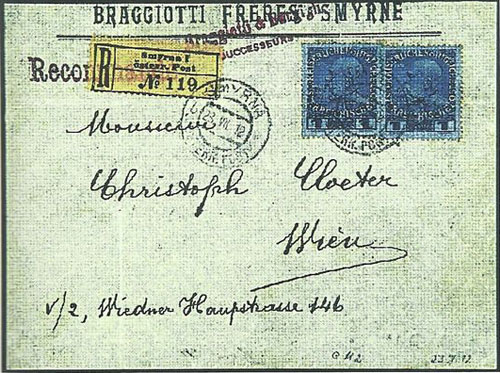 |
1912 posted card from the Braggiotti Freres shop.
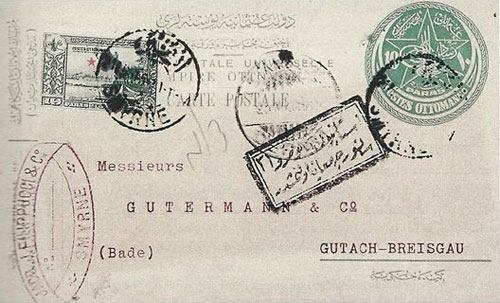 |
1915 posted card from the J. Filippucci shop.
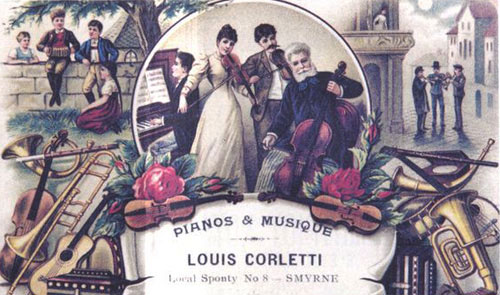 |
Advert of the Louis Corletti shop in Smyrna, 1910s.
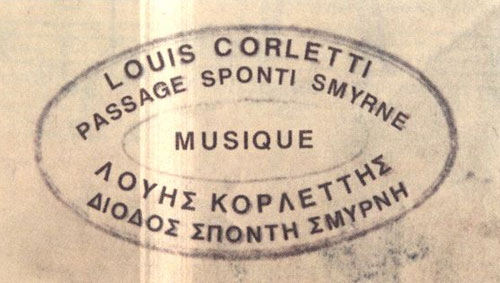 |
Stamp of the company on sheet music.
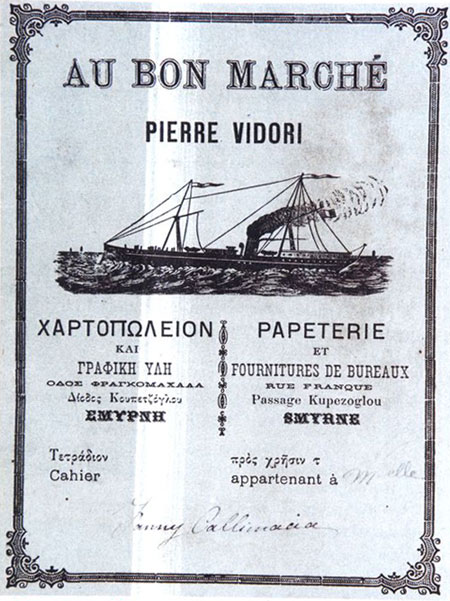 |
Children’s note-book cover by the Pierre Vidori owned Au Bon Marché shop.
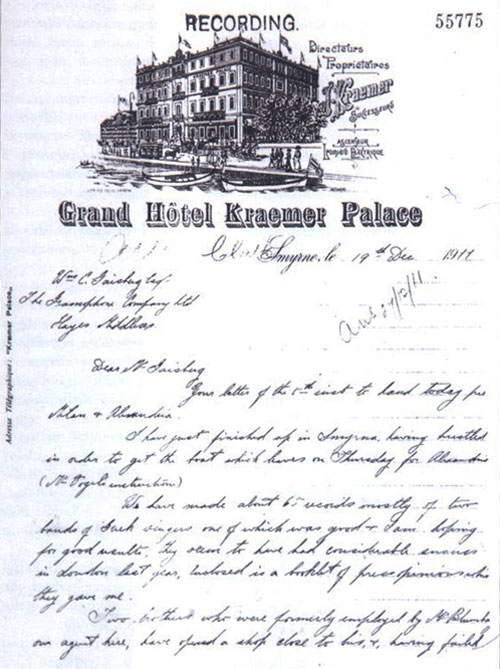 |
Letter sent from Smyrna by the EMI sound technician A. Clarke to the headquarters in England, 1911.
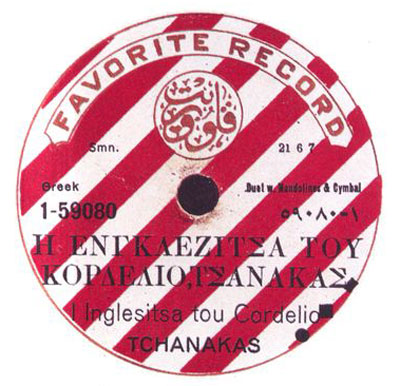 |
The inner gramaphone record label of a 1912 recording of Y. Chanakas of the song ‘the English maiden of Cordelio’.
One Cordeliotitsa blonde, with her abundant hair,
Made me mad with one of her looks... etc.
A song mentioned by Prokopiu and Kararas.
One Cordeliotitsa blonde, with her abundant hair,
Made me mad with one of her looks... etc.
A song mentioned by Prokopiu and Kararas.
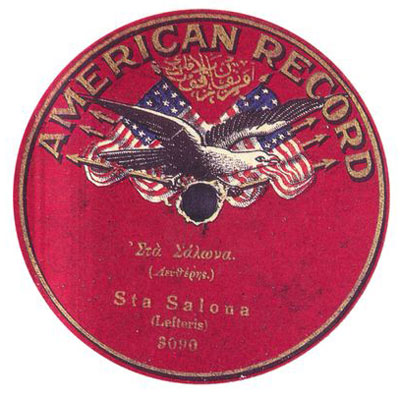 |
The inner gramaphone record label possibly recorded in Istanbul with Lefteri Menemenli ‘In the salon’.
 |
Zizi Missir (on the extreme left in dark suit) and his orchestra, late 1940s Izmir.